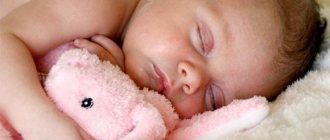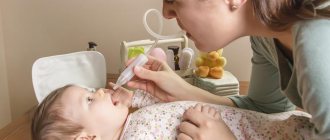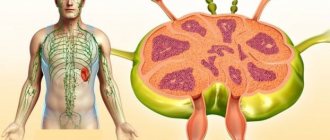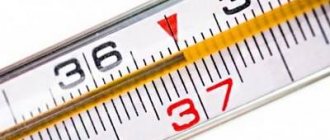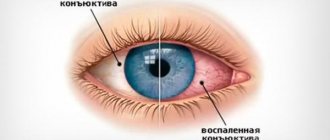The baby is cheerful, vigorous, plays actively and shows no signs of trouble. At most, they touched the forehead with the palm of their hand and thus made sure that everything was fine with the baby. Sometimes, even the opposite. Young mothers often observe that their baby seems to be hot, tactile sensations indicate that his temperature has risen, but measuring it with a thermometer, the scale does not rise above normal. In both cases, the best adviser is always a thermometer, provided that all the rules and recommendations of doctors are followed regarding when and under what conditions the thermometer readings can be considered accurate.
Features of thermoregulation in young children
If the question arises why the back of the baby’s head and forehead are hot, you need to pay attention to his age. Normal temperature in newborns is often close to 37.4 degrees.
There are a number of main features of heat exchange in infants from processes that occur in the adult body.
- The sweat glands of infants are not fully formed. The child does not sweat much and cannot cool down fully when it is hot or he is heavily bundled up. Cooling occurs due to vessels located on the surface of the skin, for example, on the back of the head. This gives the impression that the back of the head and other areas of the baby’s head are hot.
- Heat production occurs in brown adipose tissue. Only newborns have it. The thyroid gland controls this process. Producing the required amount of heat requires little energy.
- If a child is dressed in warm clothes, the body is cooled through the head, which becomes very hot. This phenomenon is normal, it is not a pathology.
- When a baby freezes, involuntary muscle contraction occurs. The child begins to cry, fuss in the crib, and the temperature rises.
Taking into account all these features, you can help your baby maintain temperature balance so that he feels comfortable and cozy.
Improper care
We've already said this, but let's go back again because this is the key point. In the maternity ward, doctors pay a lot of attention to ensuring that the baby does not freeze. They dress him, cover him with a blanket and forbid his mother to open him again. At this moment, such a measure is justified, since the body has not yet adapted to the sudden changes.
But the young mother accepts this behavior as the norm. As a result, even after discharge he continues to dress the baby warmly. He is still constantly in a lying position and is not able to control the degree of his comfort himself. Only by shouting can he communicate that something is bothering him. But if your baby is hot, he usually sleeps more.
Therefore, to prevent overheating, you need to pay attention to the air temperature in the room and outside. Pediatricians usually recommend dressing your baby as you do, plus one layer of clothing. That is, if you are comfortable in trousers and a T-shirt, then the child can lie in a cotton suit, covered with a flannel diaper.
Harmless reasons for the problem
When a baby has a hot head, but no temperature, in most cases this condition is not a pathology. Perhaps the child is dressed warmly, and in order to normalize the heat transfer process, he needs to be changed into loose clothing. You should buy clothes only from natural, breathable material.
It is important to ensure that the baby does not become overtired. A hot head can be a consequence of active, active games. It is necessary to alternate sleep and wakefulness, especially in the first months of a child’s life. A hot head in a small child often worries parents during teething. During this period, he is capricious, there is increased salivation and sweating.
If all the measures taken do not help, the head is still hot, but there is no temperature, it is better to show the baby to a specialist.
The following symptoms should alert you:
- increased sweating;
- the child is overly excitable;
- flinches at every touch, showing anxiety;
- The baby's hair is falling out a lot;
- the sleep is short, the child wakes up crying.
Help can be provided by a pediatrician, neurologist, and endocrinologist.
Why a cold forehead
It often happens that a baby has a cold forehead, no temperature, but a hot back of the head. Why does this happen - let's look at the possible reasons:
- A cold forehead may be a sign of hypothermia;
- A cold forehead occurs with ARVI;
- If poisoning occurs, vomiting is added;
- Increased intracranial pressure;
- The beginning of the development of rickets.
See a doctor urgently
Parents are confused when the thermometer shows normal, but the forehead and back of the head are hot. Questions arise: why does this happen and how dangerous is it?
A dangerous sign is when the back of the head is hot, but the forehead is cold. Hydrocephalus should be excluded. Every person's skull contains intracranial fluid. In pathological conditions, its amount increases, the brain begins to become saturated with fluid, and the disease develops.
Associated symptoms include:
- in addition to the fact that the head is hot, it is also wet;
- veins are clearly visible in the forehead and temples;
- swollen fontanel;
- the head increases in size;
- the head is often thrown back, especially when the baby is sleeping;
- frequent, profuse regurgitation is observed;
- the baby is capricious, whiny;
- muscle tone is impaired.
Another dangerous disease in which the head becomes hot, but there is no temperature, is rickets. The main reason for its development is a lack of vitamin D in the body, which promotes the absorption of calcium. At risk are infants born prematurely, who have impaired absorption of vitamins and inflammation of the digestive tract.
With a lack of vitamin D, the bones begin to soften, and the fontanel does not heal for a long time. If treatment is not started in time, the bones become deformed, the arms, legs, and chest become bent.
A hot head can be a consequence of viruses and bacteria entering the body. Colds often occur without fever, cough or runny nose. The child becomes lethargic, appetite and sleep are disturbed, and frequent regurgitation is observed.
Another reason for disruption of the thermoregulation process is infections that entered the child’s body in utero: toxoplasmosis, chlamydia, cytomegalovirus.
A hot head, but no temperature - this is observed with blood diseases, low hemoglobin (anemia) or with endocrine diseases.
Pathological processes in the body lead to improper functioning of internal organs. The first signs are sweating and a warm head. The baby becomes lethargic and capricious. In these cases, you should consult a doctor.
Hydrocephalus
Another reason for increased heat transfer through the head may be hydrocephalus. This is a serious but rare disease caused by the accumulation of intracranial fluid.
In this case, in parallel with the fever in the head, parents may observe the following symptoms:
- the head is not only hot, but also sweats a lot;
- enlarged veins on the temples or forehead are clearly visible;
- throwing the head back;
- frequent profuse regurgitation;
- restlessness, frequent crying;
- in advanced cases - an increase in the volume of the skull.
If you notice such disorders in your child, be sure to show him to the doctor, because this disease can affect brain development and cause a developmental delay from peers. Timely treatment will prevent these problems.
Therapeutic and preventive measures
If a disease has been ruled out, there is no fever, but the baby’s head is still hot, several recommendations should be followed.
- Do not allow the child to sweat.
- If the room is too hot, you can wipe your baby with a damp towel.
- Normalize your daily routine.
- Breastfeeding or adapted formula.
- The room in which the baby is located must be constantly ventilated (the optimal air temperature in the room is 20–22 degrees, humidity is no more than 70%).
- You need to spend time with your child in the fresh air as often as possible.
- Direct sunlight should be avoided. The child must always wear a hat. We need to stop wearing diapers on the street. You don't have to wear socks or shoes.
For rickets, taking vitamin D is indicated. But only a doctor prescribes the dosage and duration of treatment. For hydrocephalus, either conservative methods are used or surgery is prescribed.
Do not be afraid that your child is throwing a fever. This is not a mandatory sign of the onset of the disease. You just need to change the rules of care, and the thermoregulation processes will improve on their own.
Signs of rickets
Sometimes a hot forehead is a natural factor, there is no reason to worry, but it can be a symptom of the onset of the development of serious diseases, the main thing here is to start treatment on time to avoid possible negative consequences.
Signs of rickets:
- The bones of the skull become thinner and soften;
- The parietal bones become enlarged;
- There is a delay in the normal eruption of the first teeth;
- The ribs become covered with tubercles;
- Hair begins to fall out, bald patches appear;
- There is a noticeable curvature of the lower limbs;
- The baby’s growth slows down and becomes below normal;
- The baby begins to lag behind in physical development.
All these symptoms may indicate the onset of the development of rickets.
- a dangerous disease that changes the appearance, destroys, and incorrectly forms the formation of the baby’s bone tissue. The cause of rickets is a lack of vitamins D and Calcium.
The coincidence of several symptoms requires urgent advice from the attending physician; the doctor will make a diagnosis and prescribe treatment to prevent further development of the disease.
It is prohibited to start giving vitamins on your own; separately identified symptoms can mean the onset of completely different diseases.
Content
Taking care of the baby's health is one of the main tasks of parents. If a child cries a lot, is in an irritable mood, sleeps little or eats poorly, thoughts immediately creep in that something hurts. But there may be other explanations for this that are in no way related to diseases. But if the baby has a hot head, then the parents almost immediately come to the conclusion that the baby is sick and call the pediatrician.
Indeed, a hot head is direct evidence of elevated body temperature. But, surprisingly, this does not always mean a deterioration in well-being. A child's body works differently than an adult's. Therefore, a too warm forehead does not always mean that the baby requires medical attention.
What to do
First of all, forget about panic. Every mother tends to think about the worst, even when objectively everything is fine with her baby. If the baby is a month old or less, this situation indicates that he is hot. The baby needs to be opened up and air flow to the body must be ensured.
Regularly ventilate the room in which the newborn is located. The recommended temperature should not exceed 23 degrees. Make sure that clothes are made only from natural and breathable fabrics. In the summer, spend as much time as possible outside with your child. You can ask grandmothers how to dress a baby, they have good experience. But it is not recommended to be in the open sun for a long time, so as not to cause the child to overheat.
But once again I would like to emphasize that there is no reason to panic. Constantly monitor your baby's temperature and measure it regularly. If your head remains hot for a long time, you need to seek help from a doctor. But the temperature of a certain area of the skin can be an individual feature. This is not usually a sign of illness. Therefore, it is better to think about how to dress your baby correctly.
When is it not dangerous?
Few mothers know that the normal body temperature of a baby under 1 month of age is 37.4 o C.
Therefore, if you discover that the baby has a hot nape, you should not raise the alarm - for a child’s body a slight increase is normal: the baby learns to live in our environment, and not in the mother’s womb, and this process requires some getting used to.
In addition, sweat glands continue to form in infants after birth. In the first months they do not function fully, so the baby sweats little. Sweat acts as a cooling substance when a person is hot - this is how it protects the body from overheating. Since this mechanism is imperfect in babies, even excessively warm clothing leads to overheating of the body and, as a result, an increase in body temperature.
Cooling at this age occurs with the participation of vessels that are located on the surface of the skin, including on the back of the head. Heat escapes through them, therefore, touching the back of the head of infants, you will notice that it is often much warmer than, for example, the forehead or shoulders.
A warm head may also be because the baby is... Freezing!
This seems like a paradox, but in fact, everything is quite logical: the body reflexively reacts to the cold by trying to warm up. The muscles contract more actively, and fussing in the crib begins. As a result of intense work of the body, its temperature also rises.
So it turns out that a hot head is not always a symptom of a disease. But other situations are also possible...
Treatment
With such a symptom, when the baby constantly has a hot head, and the cause is not any specific disease, the baby’s heat exchange should be stabilized.
The child should be dressed in such a way that he does not sweat at all.
The baby's clothes should certainly consist only of natural materials. When the child is hot in the room, it is allowed to wipe the body with a damp towel. A stuffy room must be ventilated.
Slightly older children need to be switched to a mode of sedentary, exciting play, which will allow them to establish a normal thermal regime. Excessive activity causes the head to heat up.
It is advisable to spend more time walking with your baby outside. In summer, wear light clothing, leave your legs free, and let the baby's body breathe. You should also not wear diapers, since in hot weather the baby will not feel comfortable in them.
If a baby always has a hot head, the main reason for which is rickets, then measures to improve the baby’s health consist of the following procedures:
- Therapeutic actions begin with normalization of the regimen;
- An important point is that the baby stays in the fresh air as often as possible;
- He must always be in a well-lit, thoroughly ventilated area;
- Breast milk, which contains an optimal balance of elements, remains the optimal nutrition for infants;
- In the absence of breastfeeding, it is replaced with adapted formulations.
When a baby is diagnosed with progressive hydrocephalus, consultation with a neurosurgeon is required. Bypass surgery may be needed. When the disease is in the compensation stage, conservative therapy is performed, monitoring the state of the brain using ultrasound.
Physical therapy is indicated, which normalizes muscle tone and helps develop motor skills. The maximum effect is achieved by massage performed by a well-trained specialist.
The normalization of education, as well as the acceleration of fluid absorption in the brain, is facilitated by a procedure such as microcurrent reflexology. After the procedures, the baby’s sleep improves, motor activity is observed, and excitability is significantly reduced. The baby is gradually catching up with his peers in development. The most effective is complex treatment.
When is it dangerous?
In some cases, an increase in body temperature indicates that an inflammatory process is occurring in the body. And this is already quite an alarming signal. The fact is that the most common diseases - acute respiratory viral infections (or ARVI) - often cause complications in the first year of life. This is due to the fact that the body has not yet developed the protective reactions it needs so much and simply does not know how to fight both viral and bacterial diseases. Therefore, any illness in infants should not be left untreated. Otherwise, complications such as encephalitis, meningitis or pneumonia are possible.
Babies born prematurely, as well as newborns who are bottle-fed, are especially at risk. It has been proven that infants who are fed mother's milk retain their mother's immunity to diseases up to 6 months of age - antibodies are transferred along with food. After this age limit, milk changes its composition, and the baby eats less of it, as complementary foods are gradually introduced - and protective immunity weakens.
Causes of colds without fever
Why does a cold appear without fever? To begin with, it must be said that a cold occurs due to the penetration of one of the 200 currently known strains of viruses into the body. Of these, the most active are rhinoviruses from the picornavirus family. As soon as the virus enters the human body, it begins to actively multiply in it, which leads to the occurrence of an inflammatory process. The upper respiratory tract begins to be affected by diseases in the form of nasopharyngitis, acute runny nose, and nasopharyngitis. Why does a child, and an adult too, most often catch a cold during the off-season - autumn-winter or winter-spring? Everything is explained quite simply - because viruses begin to actively multiply during this period.
Main symptoms
If an infection develops in the baby’s body, this is immediately visible by external signs, such as:
- lethargy, drowsiness;
- nasal congestion;
- poor appetite;
- cough;
- increase in body temperature.
The symptomatic set depends on the nature of the disease. But it should be noted that babies under six months old do not know how to cough, for example - newborns anatomically do not have this ability. This means that they will also not be able to cough up mucus or remove it from the bronchi.
They also do not know how to blow their nose - it is for this reason that a baby’s nasal congestion is often accompanied by poor appetite: it is difficult for them to both breathe and eat at the same time. Moreover, with proper latching of the breast or nipple, air should not enter the oral cavity. And if your throat hurts, it’s hard to swallow - this also affects the volume of the portion you eat.
How to treat a baby
Treatment of a newborn is complicated by the fact that most medications are contraindicated at such a tender age. And what is permitted should be used strictly as needed and in the dosage specified by the manufacturer. In any case, at the first signs of illness, you need to call a pediatrician (this is preferable to going to the clinic for an appointment, since in the clinic there is a chance of catching another virus) - only he will be able to competently examine the baby’s neck, listen to the lungs for the absence of wheezing, and carry out the rest examination necessary to make a diagnosis, as well as prescribe how to treat the patient.
Parents can take the following measures to ensure the baby’s speedy recovery:
- do wet cleaning daily without using household chemicals;
- Ventilate the room twice a day, and it is advisable to take the baby out of the room for a while;
- minimize water treatments both in quantity and time;
- provide plenty of fluids - up to 100 ml per day, and at high temperatures - moisturize the limbs with a wet towel;
- if there is no temperature, walk in the fresh air, avoiding contact with other children and adults.
You should be very careful when using traditional methods of treating diseases.
It is strictly forbidden to wipe babies with vinegar or vodka (which is sometimes done to reduce the temperature). You cannot use folk medicines based on honey, raspberry jam or even cow's milk if these products have not yet been introduced into the children's diet.
By the way, new foods should not be introduced during illness - it is better if the body spends energy on overcoming the disease, and not on getting to know the food.
Don't be afraid of childhood illnesses - they are inevitable. Curing a cold in a baby is not a difficult task, but it requires strict adherence to the doctor’s recommendations. If everything is done correctly, the baby will soon recover, and his body will tolerate the next illness more easily, since it will already have experience in fighting ARVI.
Doctor's advice
Dr. Komarovsky, a famous Russian and Ukrainian doctor, a good pediatrician, uses his own method of preventing diseases.
Let's look at the most popular advice given by Dr. Komarovsky:
- Bath more often. The baby must be bathed every day, this normalizes blood circulation, strengthens the body, and prevents the occurrence of various diseases;
- The mother can give the baby a daily massage; massage has a positive effect on the mental development, as well as the physical health of the child;
- It is necessary to give plenty of fluids; water normalizes the process of energy exchange and regulates temperature;
- You cannot swaddle your baby tightly;
- Do not wear tight clothes;
- You need to spend a lot of time outdoors.
ogrudnichke.ru
How does thermoregulation work in newborns?
In both children and adults, body temperature is regulated by the hypothalamus, a special section located in the diencephalon. But at the same time, the endocrine and nervous systems play an equally important role in this process. Thus, the thyroid gland, adrenal glands and pituitary gland directly influence the body's production of heat. In general, thermoregulation is a complex of chemical and physical processes that give a person the opportunity, if necessary, to increase or, conversely, reduce heat production.
The muscles and digestive organs, in particular the liver, help the body “warm up”. This mechanism largely involves the chemical processes of thermoregulation, which, as research shows, are quite well developed in newborn babies. On the contrary, the vascular system is responsible for heat transfer, as well as sweating. Due to their special physiology and insufficient development of the skin, it is more difficult for children to cool themselves. That is why a baby with a hot head without fever is a normal condition. This, as a rule, is not associated with problems in the body; the cause of this condition is most often simple overheating.
From the moment of birth, the child is nevertheless able to cope with the challenges that the environment throws at him. In the womb, he was in waters whose temperature is close to 38 degrees, so when he is born, he experiences a shock, because he finds himself in a place where it is 10-14 degrees colder. Brown adipose tissue helps it cope with such temperature changes; it begins to form in the fetus around the 26th week of pregnancy and accumulates in the body until birth. The baby will use it to keep warm for approximately the entire first year of its life.
Premature babies do not have as much brown fat as babies born at term, so their thermoregulation is much worse. The second feature of babies is that their muscles do not contract during heat production. That is, if a child does not shiver in the cold, this does not mean that he is not frozen. To determine this, it is better to feel the child. If a baby has a hot head, it means that he is hot, and cool skin may indicate that he is hypothermic.
Nuances of thermoregulation in infants
Every person, as well as every mammal, has a constant body temperature. Such constancy is considered the result of proper thermoregulation of the body, which ensures metabolic processes. They are under the control of the central and nervous system, as well as the hypothalamus. It is the latter that receives signals from nerve endings and redirects them to various systems of the body. In turn, heat exchange is carried out due to heat production and heat transfer.
In an infant, heat production occurs due to oxidation in brown adipose tissue. The latter is present only in the fetus and newborn child. Brown fat begins to be produced in the fetus's body starting from the 26th week of pregnancy. By the time a baby is born, brown fat makes up about 8% of its total body weight.
This mechanism works as follows: due to the work of the thyroid gland, the greatest amount of heat is produced at the lowest energy costs. Muscle tremors are the second, but no less important mechanism in the process of heat transfer. If the baby's body temperature drops, his muscles begin to involuntarily contract, thereby raising it.
Therefore, when an infant has a hot head, but there is no temperature, there is nothing to worry about. Most likely, this is how the peculiarity of thermoregulation of this particular child is expressed. In order for the baby's head to become normal temperature, he should be undressed a little and provided with an influx of fresh air. In addition, the child’s clothes should be made exclusively from natural fabrics.
By the way, the increased activity of the baby also leads to the fact that his head becomes too hot. Therefore, it is better to alternate active games with calm ones so that the child’s thermoregulation has time to work correctly.
But if you follow all the above rules, and the child’s head remains hot, you should consult a doctor. Before you do this, you should also pay attention to the following symptoms:
- increased anxiety;
- excessive excitement;
- sweating;
- hair loss.
We are accustomed to the fact that a hot head is the first sign of illness. It is at high temperatures that the forehead becomes hot, however, when it comes to a child, all the usual theories collapse, since the little person’s body is structured somewhat differently.
Features of temperature of different parts of the body in children
Also, mothers often notice that the baby has a hot head, but his hands and feet are completely cold. In such cases, the child urgently needs to measure the temperature, and if its increase is recorded, it means that a serious inflammatory process is most likely present in the body. Due to vascular spasm, the body cannot lose heat through the skin of the palms and soles, and accumulates it inside the body, causing the temperature to rise more and more.
This condition is extremely dangerous for babies and requires immediate medical attention. In general, research by doctors has shown that the temperature on the surface of different parts of a child’s body is usually different. This is due to the fact that in some places there are more blood vessels. Thus, in the central part of the body the temperature is higher, and in the periphery it is lower. At the same time, the toes are the coldest (in newborns, 31.7 degrees). Having felt the baby, parents may notice that the baby without fever has a hot head in the temples and a cool forehead. This is absolutely normal and is associated with the same uneven coverage of blood vessels in the skin.
Hot body and head without fever
Most often, people notice that they have a hot head or body during colds, infectious diseases or other conditions accompanied by hyperthermia, i.e. fever. An elevated temperature is a sign of poor health, so at the slightest suspicion a person grabs a thermometer. Even more often, parents notice that the child has a hot forehead or back of the head. But when the thermometer shows normal values, people are at a loss - why is the body hot without temperature?
The content of the article
Normal temperature for children under one year old
A slight “warming” of the body in a newborn is quite normal. As we have already said, if the baby’s temperature fluctuates between 36.5–37.5 degrees, this is quite natural and acceptable. During sleep, the child may get a little hot, so it makes no sense to put a thermometer on him while he is asleep. Such a measurement of body temperature will be uninformative, because it will most likely show hyperthermia, which will go away on its own after about half an hour. Also, a child can become hot if he is not dressed correctly, using a lot of clothes or things made of synthetic fabrics. If the temperature rises, you can try to undress the baby, and if the situation stabilizes, then it is not a matter of illness, but of overheating.
Is a hot head in a baby a symptom of illness or normal?
In itself, an increase in temperature in the head area does not mean anything. This can become a symptom only along with other characteristic signs of diseases:
- restlessness;
- poor sleep;
- weak appetite;
- urinary retention and constipation or, conversely, diarrhea;
- frequent, causeless crying.
These symptoms may indicate an infectious or neurological disorder.
Sweating head in a child
Parents often ask pediatricians why their baby’s head is sweating. According to a number of experts, this is due to a deficiency of vitamin D in the body and rickets, but not all doctors adhere to this point of view. To confirm this diagnosis, you need to consult a neurologist and orthopedist, and also donate blood for biochemistry.
Another probable cause of head sweating is underdeveloped sweat glands, overstimulation, the use of synthetic clothing and downy bedding, intense sucking (this makes the child tired; sucking is a serious physical activity for the baby).
Baby's forehead is hot
Hello, the baby is 2.5 months old. Constantly hot and damp forehead. I measure the temperature periodically from 36.9 to 37.2. Mostly 36.9. He poops well, eats well, and is rarely naughty. Is this the norm?
Hello! If your baby eats well, gains weight, and develops according to his age, then this temperature is normal for him. The fact is that children from birth until almost 6 months do not know how to adequately respond to heat and cold. This thermoregulation function is not yet available to them. Your task is to create the most comfortable conditions for the newborn. That is, the temperature in the room should be 22 - 24 degrees, the child’s clothes should be light and made of natural materials. You shouldn’t wrap him up in hats, socks, or mittens at home. Maintain humidity at 40 - 60%. Let your child drink plain water, a little, a tablespoon a day. During illness, the child becomes restless, eats poorly, sleeps poorly, and as a rule, children develop a fever very quickly, so watch this closely. Contact your pediatrician immediately if you feel your baby is sick.
is provided for informational purposes only. Based on the results of the consultation received, please consult a doctor, including to identify possible contraindications.
Good day! Our baby is already a year and 11 months old. but in recent days the back of his head has become very hot, while his forehead and body are cool, there is no temperature. I give...
Hello, please give me some advice. A month ago we had a routine vaccination against polio. The temperature was not taken before vaccination. The child is 6 months old. Before this, they also didn’t measure much, because there was no need. We have…
Parents of young children are often concerned about the question: “why does the baby’s head sweat?”
In most cases, this condition is associated with the peculiarities of individual metabolism in a child under one year old and the beginning of functioning with further differentiation of the thermoregulation system, skin and sweat glands, changes in hormonal levels, especially during the period of adaptation of the baby to new living conditions - adaptation of the baby’s skin to the effects of temperature and ambient air.
The reasons for sweating of the head in the first months of a baby’s life can be: violation of the temperature regime in the apartment, improper care of the skin (rare bathing, abuse of oils, wrapping and warmer clothes (out of season) or the use of clothes made of synthetic fabrics), hot season also stimulates increased sweating.
Also, increased sweating of the head in a baby can be observed during feeding or crying due to the baby’s increased physical activity, especially in weakened babies (with congenital malnutrition) and as a result of a hereditary predisposition to excessive work of the sweat glands.
How to cool a child?
Before you start “bringing down” the temperature, you need to find out the reason for its increase. To do this, you need to understand why the baby has a hot head and other parts of the body. If it is a disease, then it needs to be treated under the guidance of a competent medical professional.
If the fact is that the baby is overheated, you need to do everything possible to remove the factors contributing to his hyperthermia. To begin with, the child should be undressed; you can wipe his hands, feet and head a little with a damp cloth. This will help the fever go away faster and the temperature will return to normal. It is also very important to maintain a normal microclimate in the room where the newborn is located most of the time. Despite the fact that while in the womb it is accustomed to warmth, after birth it does not need to be raised like a greenhouse plant in a hot and stuffy room. It is more correct to maintain the temperature at 22-24 degrees and no higher, and air humidity - from 40 to 60%.
The child is hot but there is no temperature Komarovsky
Published by admin on March 30, 2019
What to do if your child starts to have all the signs of a cold, but there is no temperature? And is it a cold? Maybe something else needs to be treated? This is surprising, but despite the fact that medicine and modern technology have come far ahead, many of us (including doctors) call a severe viral and infectious disease of the respiratory tract a cold. Moreover, a cold is most often understood as a pathological condition characterized by high fever, cough, runny nose, sore throat and weakness in the body. But, even if any symptom is missing from this list, the disease will not cease to be viral in nature and be identified as a cold.
Where in the head should a child's temperature rise be checked?
Many parents, kissing their child on the forehead, check whether he has a fever. This method of controlling temperature rise has truly been proven over generations. But you need to understand that by touching this part of the head, you can only determine whether the baby has a fever at all, but this method will never give an accurate result. In addition, it is important not to miss when carrying out such a diagnosis and not to kiss the baby on the temple, where, in principle, the skin is much warmer, and it may seem that the baby has a temperature of 37 degrees or even higher.
Sources:
https://grudnichky.ru/zdorove/goryachaya-golova-u-grudnichka.html https://mirgrudnichka.ru/zdorove-i-lechenie/goryachaya-golova-u-grudnichka.html https://fb.ru/ article/402629/u-grudnichka-goryachaya-golova-prichinyi-osobennosti-termoregulyatsii-u-malenkih-detey
